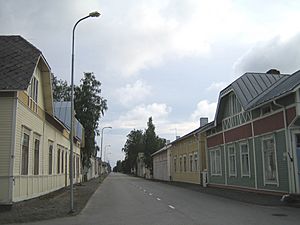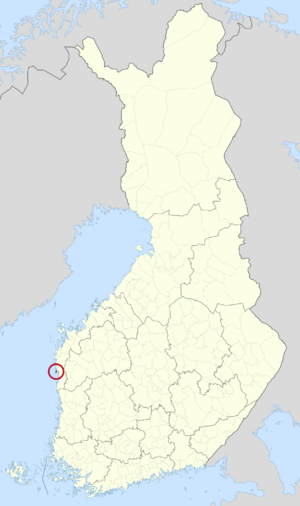Kaskinen facts for kids
Quick facts for kids
Kaskinen
|
||
|---|---|---|
|
Town
|
||
| Kaskisten kaupunki Kaskö stad |
||

Kaskinen
|
||
|
||

Location of Kaskinen in Finland
|
||
| Country | ||
| Region | Ostrobothnia | |
| Sub-region | Sydösterbotten | |
| Founded | 1785 | |
| Area
(2018-01-01)
|
||
| • Total | 175.36 km2 (67.71 sq mi) | |
| • Land | 10.64 km2 (4.11 sq mi) | |
| • Water | 164.87 km2 (63.66 sq mi) | |
| Area rank | 312th largest in Finland | |
| Population
(2023-12-31)
|
||
| • Total | 1,208 | |
| • Rank | 286th largest in Finland | |
| • Density | 113.53/km2 (294.0/sq mi) | |
| Population by native language | ||
| • Finnish | 58.8% (official) | |
| • Swedish | 27.5% (official) | |
| • Others | 13.7% | |
| Population by age | ||
| • 0 to 14 | 11.2% | |
| • 15 to 64 | 47.1% | |
| • 65 or older | 41.7% | |
| Time zone | UTC+02:00 (EET) | |
| • Summer (DST) | UTC+03:00 (EEST) | |
| Unemployment rate | 65% | |
| Website | www.kaskinen.fi | |
Kaskinen (pronounced KAS-ki-nen in Finnish, or Kaskö in Swedish) is a small town located on an island in Finland. It's on the west coast, in the Ostrobothnia region, right by the Gulf of Bothnia. Kaskinen is unique because it's the smallest municipality in Finland that has "town" status.
The town is on an island, connected to the mainland by two bridges. Its only neighbor on land is the town of Närpes. Kaskinen is known for its many wooden buildings. Even though it was planned as a port town, a railway also connects it to the main Finnish railway network. Today, this railway is mostly used for moving goods to and from the Port of Kaskinen.
Kaskinen is a bilingual municipality. This means both Finnish and Swedish are official languages here. Most people speak Finnish, but a good number also speak Swedish.
The coat of arms of Kaskinen shows a paddle. This paddle represents the town's excellent natural harbor, which was important for its founding. The laurel leaf on the coat of arms might mean growth and prosperity. It could also be a nod to the Bladh family, who helped the village become a town.
Contents
What's in a Name? The Etymology of Kaskinen
The name "Kaskinen" has a cool history! Older names for the island include Kaskisöyen and Casköö. The Finnish name "Kaskinen" is the original one. In old Swedish island names, the word Kaskis- was used, with -ö added, which means "island" in Swedish.
The most likely meaning of the island's first name is Kaskisaari, which means "Slash-burn island." This suggests that people used to clear land by burning trees (called slash-and-burn) on the island a long time ago to grow crops.
A Look Back: The History of Kaskinen
Kaskinen was founded in 1785 by King Gustav III of Sweden. Since then, it has been an important harbour in Finland. In the 1700s, a plan was made for the town with long, straight, and wide streets. This plan was for a much larger population than Kaskinen ever had. Even today, some parts of the town that were planned are still empty land.
In the 1800s, the town grew slowly because it was hard to get to. A bridge to the mainland was finally finished in 1828. Kaskinen was a maritime (sea-focused) town. However, it was not as big as other towns like Kristinestad or Vaasa. For a long time, fishing and trading were the main ways people made a living.
In the mid-1800s, when sailing ships were very popular in Finland, Kaskinen was a busy port. They mainly exported tar and timber (wood). At its busiest, the town had 12 sailing ships. After sailing ships, steamships took over. They carried goods and passengers along the coast and even to Sweden.
In 2019, Kaskinen and its neighbor, Närpes, considered joining together as one municipality. However, Kaskinen's town council voted against it by a very close margin.
How Kaskinen Makes Money: The Economy
Kaskinen has a working economy, with many jobs in different areas. In 2015, there were 479 jobs in the town.
- A small part of these jobs (about 5%) were in primary production, like agriculture (farming), forestry (working with trees), and fisheries (fishing).
- A larger part (about 40%) were in processing, which means making things. This was higher than the national average for Finland.
- The biggest part (about 54%) were in services, like shops, restaurants, and other businesses that help people.
The town is home to the Port of Kaskinen, which is very important for the local economy. This port handles a lot of cargo transport, meaning it moves goods in and out of Finland by sea.
Who Lives in Kaskinen? Demographics
The chart below shows how Kaskinen's population has changed over the years. Like many small towns, its population has slowly decreased.
| Kaskinen's population growth in 1990–2020 | ||||
|---|---|---|---|---|
| Year | Population | |||
| 1990 | 1 780 | |||
| 1995 | 1 596 | |||
| 2000 | 1 564 | |||
| 2005 | 1 482 | |||
| 2010 | 1 429 | |||
| 2015 | 1 285 | |||
| 2020 | 1 278 | |||
| Source: Statistics Finland. | ||||
Culture and Traditions
Tasty Traditions: Kaskinen's Food
If you visit Kaskinen, you might hear about a traditional dish called Gubbe ronka or gubbe runka. This dish is made from mashed potatoes mixed with salted Baltic herring. It's usually served with mashed lingonberry and melted butter. This unique dish was named Kaskinen's traditional parish dish in the 1980s.
Famous Faces from Kaskinen
Some notable people have come from Kaskinen:
- Rosina Heikel (1842–1929), a medical doctor and an early supporter of women's rights.
- Krista Siegfrids (born 1985), a pop singer who represented Finland in the Eurovision Song Contest.
- Sune Mangs (1932-1994), a well-known actor.
Images for kids
-
King Gustav Square (Finnish: Kuningas Kustaan aukio)







